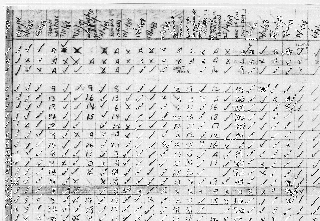An example of 'cricket score' assessment, taken from the 1970s
 The ticks and crosses are for attendance or
absence, the numbers are totals for marks gained on pieces of work. These could
be aggregated to produce a class order for a month, a term or a year (normative
assessment). The ticks and crosses are for attendance or
absence, the numbers are totals for marks gained on pieces of work. These could
be aggregated to produce a class order for a month, a term or a year (normative
assessment).
At the end of a term, a pupil might have, for instance, a total of
452 marks, the ninth highest total out of a group of 30 pupils, but exactly
what does '452' mean?
How much help is this in enabling us to determine what
his or her strengths and weaknesses in the subject are, or in helping us to
talk to parents at parents' evening, or in talking to individual pupils about
what they need to do in order to improve in the subject?
It is worth noting, however, that as early as
1964, John Holt was writing about the need to assess for understanding, and the
limitations of retention and regurgitation testing:
'I feel I can understand something if I can
do some, at least of the following:
1.State it in my own words
2. Give examples of it
3. Recognise it in various guises and
circumstances
4. See connections between it and other facts
or ideas
5. Make use of it in various ways
6. Foresee some of its
consequences
7. State its opposite or converse
This list ... may help us... find out what
our students really know, as opposed to what they can give the appearance of
knowing, their reallearning, as opposed to their apparent
learning.'
John Holt (1964) How children learn,
London, Penguin, p. 177.
Moves towards 'breaking subjects down' into 'components'
The 70s and 80s saw a move towards 'breaking
subjects down' into 'components', in order to try to establish what bits of a
subject pupils were good at and where they needed to improve.
Figure 1 shows that the history department
has 'broken down' performance in history into 4 main criteria, which are
designed to provide a profile of how the pupil is doing in the subject;
to show where they are performing well, and where they are not doing as
well.
|
Fig. 1
|
Term 1
|
Presentation of work
|
Sourcework
|
Essay work
|
General Knowledge and
understanding of history
|
Exam Mark
|
|
4G
|
Green, L.
|
B
|
B
|
B
|
B
|
53
|
|
|
Jenkins, H.
|
B
|
C
|
C
|
B
|
41
|
|
|
Laski, B
|
C
|
D
|
D
|
D
|
29
|
|
|
Russell, B.
|
A
|
C
|
B
|
D
|
38
|
|
|
Taylor, A.
|
E
|
D
|
E
|
D
|
7
|
|
|
Williams, N
|
A
|
B
|
A
|
C
|
49
|
Another fairly common policy in assessment
(variations of which are still used today) was to give pupils a grade for
attainment and a grade for effort, (usually on an A to E scale) accompanied by
a general comment on the end of year report to parents: see Figure
2:
|
Figure 2
1 B Humanities
|
Attainment
|
Effort
|
Comment
|
|
Imran Afsar
|
B
|
B
|
Understands basic concepts but tends to be
untidy.
|
|
Abdul Butt
|
B
|
C
|
Must improve his written work. Could try
harder.
|
|
Adam Baxter
|
C
|
A
|
Tries hard, good homeworks, but finds the work
difficult.
|
|
Ahmed Choudhury
|
C
|
D
|
Work left unfinished, behaviour could be
improved.
|
The 1980s were to see a move towards much
greater disaggregation of achievement and progression in subjects
1980s
Back to Assessment Homepage
Back to History PGCE
|